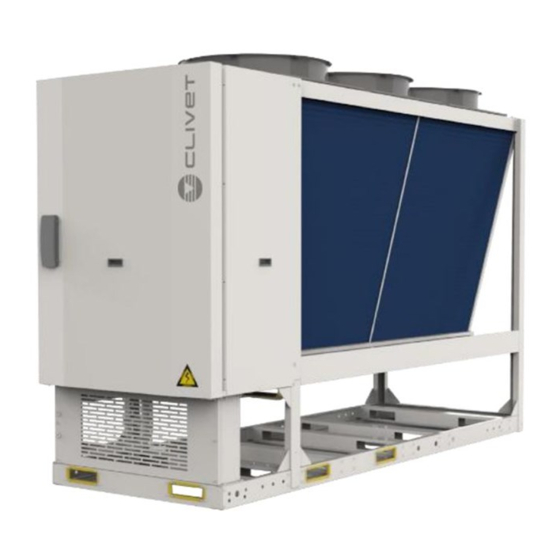
Table of Contents
Advertisement
Advertisement
Table of Contents

Summarization of Contents
General
Manual Overview and Safety Guidance
Covers the manual's purpose, safety warnings, and prerequisites for operation.
Operational Guidelines and User Support
Details intended use, installation, maintenance, breakdown handling, and user training.
Unit Identification and Refrigerant Data
Provides information on the unit label, serial number, and R32 refrigerant properties.
Data Updates and Service Information
Information on keeping data current and requesting service.
Reception
Delivery Checks and Storing Procedures
Verifying unit condition upon delivery and storage requirements.
Handling and Packaging Removal
Safe methods for moving and unpacking the unit.
Positioning
Functional Spaces and Airflow Management
Defines functional spaces and airflow requirements for optimal operation.
Unit Placement and Installation Standards
Covers placement, vibration, protection, and installation rules.
Component Specifics: Valves, Condensate, Mounts
Details pressure relief valves, condensate, and anti-vibration mounts.
Protection Grilles (Option)
Information on optional protection grilles for units.
Water Connection
Hydraulic System Design and Water Quality
Pipe design for minimal pressure drops and water purity specifications.
Freeze Protection and Flow Rate Management
Procedures to prevent freezing and manage water flow.
User Side Connection Diagrams
Illustrates connections for different unit configurations.
DHW and Modular Water System Configuration
Details Domestic Hot Water functionality and modular water setup.
Modular Unit Accessories and Start-up
Information on kits for modular units and system start-up.
Electrical Connections
Electrical Line Requirements and Safety
Covers line characteristics, protection devices, and cable sizing.
Signal, Power, and Disconnector Guidelines
Provides guidance on cable routing, power input, and disconnector use.
Customer Connections and Terminal Layout
Details wiring for customer connections and main board terminals.
Modular Configuration and Control Wiring
Setup for modular systems, addressing, and controller wiring.
Modbus
Modbus Functionality and Specifications
Explains how to enable Modbus read/write and RS-485 specifications.
Modbus Register Maps and Data Points
Details register descriptions for single and modular units.
Modbus Status Query and Fault Code Interpretation
Interprets status codes and error messages accessed via Modbus.
Start-Up
General Start-up Requirements and Safety Checks
Covers technician qualifications, safety checks, and preliminary inspections.
Step-by-Step Sequence and Circuit Preparation
Detailed sequence for unit activation, refrigerant, and water systems.
Electrical, Heater, Flow Rate, and Remote Checks
Verifying electrical, heating, flow, and remote control functions.
Compressor, Load, and PED Compliance
Details compressor operation, load data, and regulatory compliance.
Modular Unit Start-up Logic and Examples
Explains how units start and stop in a group, with examples.
Control
Control Interface Navigation and Display Icons
Describes button operations and the meaning of display symbols.
General Operations and User Menu Access
Covers basic navigation, unlock, ON/OFF, and user menu access.
Timer, Setpoint, and Temperature Compensation
Details programming timers, dual setpoints, and temperature compensation.
Domestic Hot Water and Auxiliary Heater Control
Enabling and configuring DHW and auxiliary heating functions.
Troubleshooting
Alarm Handling and Master Unit Protection
Procedures for resetting alarms and identifying master unit protection causes.
Specific Error Codes and Troubleshooting
Details various error codes and their recommended remedies.
Status Display Codes and Interpretation
Interpreting status codes displayed on the unit's interface.
Maintenance
General Safety Precautions for Maintenance
Covers area checks, work procedures, fire safety, and ventilation.
Refrigerant Handling and Component Safety
Guidelines for handling leaks, recovery, and electrical safety.
Inspection Schedules and Component Maintenance
Recommended inspection frequencies and specific maintenance tasks.
Component Replacement Procedures
Provides visual guidance for replacing key unit components.
Decommissioning
Unit Disconnection and Environmental Safety
Procedures for safe disconnection and preventing spills.
WEEE Disposal Guidelines
Regulations for the proper disposal of electrical equipment.
Residual Risks
General Risk Areas and Handling Safety
Identifies danger zones and outlines safe handling practices.
Electrical, Refrigerant, and Hydraulic System Risks
Highlights hazards related to electrical, refrigerant, and hydraulic systems.
Dimensional Drawings
Dimensions for Size 18.2 - 20.2
Technical drawings and specifications for unit sizes 18.2 and 20.2.
Dimensions for Size 25.2 - 30.2 - 35.2
Technical drawings and specifications for unit sizes 25.2, 30.2, and 35.2.
General Technical Data
Performance Data by Application
Heating and cooling performance metrics across different applications.
Construction, Calibration, and Flow Rates
Details unit construction, calibration parameters, and water flow rates.
Sound Level Data and Operating Ranges
Presents noise emissions data and unit operating limits.
















Need help?
Do you have a question about the WSAN-YES 20.2 and is the answer not in the manual?
Questions and answers